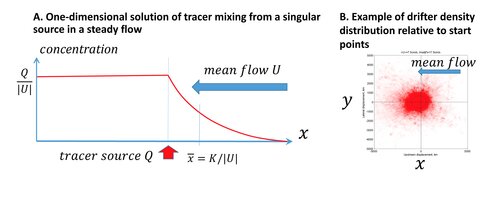Abstract's details
Particle diffusion against mean flow as a new framework for local estimate of mixing coefficient
CoAuthors
Event: 2015 Ocean Surface Topography Science Team Meeting
Session: Science II: Mesoscale and sub-mesoscale ocean processes: current understanding and preparation for SWOT
Presentation type: Type Poster
Contribution: PDF file
Abstract:
One of classical methods, used to estimate mixing coefficient, utilizes the rate of dispersion of particles from a source or from initial locations. This method is based on the assumption that on times significantly larger than Lagrangian time scales steady asymptotic statistic exists. The “cloud” of particles expands in time that limits the ability of the method to resolve complex structures. In addition, calculations are performed in a coordinate system, moving with the mean flow, so that, when the flow is strong, it may be difficult to translate Lagrangian information in to Eulerian grid needed for practical applications.
Such method implies the existence of sufficient spectral gap between scales of resolved (large-scale, time-averaged or slowly changing) currents and anomalies (traditionally referred as “eddies”). At the same time, recent studies reveal a tremendously complex structure of the mean ocean circulation, in which fronts remain sharp and narrow even on long-time averages and long-living, coherent mesoscale eddies are often organized along preferred paths, producing a weak but persistent “texture” of the mean ocean circulation.
Our study proposes a new technique, allowing to increase spatial resolution of the mixing coefficient estimates, by converting Lagrangian trajectories into Eulerian probability density function near the source. The method is based on the analytical solution of the diffusion equation for a tracer released from a singular source in the presence of a mean flow (A in Figure) and generalized for two-dimensional case and for particles with a finite life span (B in Figure). The method characterizes excursions of the particles against the mean flow and uses them to estimate mixing. For the same mixing coefficient, the stronger the flow the weaker are the excursions. We show that in most areas of the real ocean excursions of satellite-tracked drifting buoys against the mean flow are relatively small that justifies our method. Results of the analysis of simulated particle trajectories, derived from satellite data of altimetry and scatterometry and consistent with the actual drifter “spaghettis”, are used to study the factors controlling the intensity of the multi-scale horizontal mixing near the ocean surface.
Figure caption. (A) Analytical solution of one-dimensional mixing equation with a singular tracer source in a steady flow. (B) Example of drifter density distribution relative to start points.
Such method implies the existence of sufficient spectral gap between scales of resolved (large-scale, time-averaged or slowly changing) currents and anomalies (traditionally referred as “eddies”). At the same time, recent studies reveal a tremendously complex structure of the mean ocean circulation, in which fronts remain sharp and narrow even on long-time averages and long-living, coherent mesoscale eddies are often organized along preferred paths, producing a weak but persistent “texture” of the mean ocean circulation.
Our study proposes a new technique, allowing to increase spatial resolution of the mixing coefficient estimates, by converting Lagrangian trajectories into Eulerian probability density function near the source. The method is based on the analytical solution of the diffusion equation for a tracer released from a singular source in the presence of a mean flow (A in Figure) and generalized for two-dimensional case and for particles with a finite life span (B in Figure). The method characterizes excursions of the particles against the mean flow and uses them to estimate mixing. For the same mixing coefficient, the stronger the flow the weaker are the excursions. We show that in most areas of the real ocean excursions of satellite-tracked drifting buoys against the mean flow are relatively small that justifies our method. Results of the analysis of simulated particle trajectories, derived from satellite data of altimetry and scatterometry and consistent with the actual drifter “spaghettis”, are used to study the factors controlling the intensity of the multi-scale horizontal mixing near the ocean surface.
Figure caption. (A) Analytical solution of one-dimensional mixing equation with a singular tracer source in a steady flow. (B) Example of drifter density distribution relative to start points.
